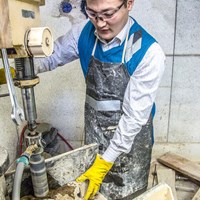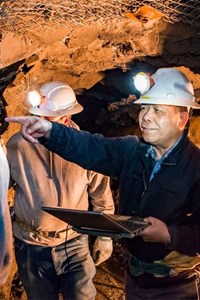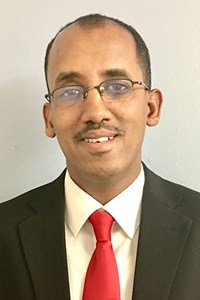
Faculty expertise and facilities in mine engineering includes mine ventilation, systems engineering, and artificial intelligence. Laboratory and software capabilities include ventilation instruments, VentSim, Vulcan, computational fluid dynamics packages, and a suite of programming languages.

The Rock Mechanics Laboratory is a well-equipped rock testing facility and includes digitally controlled load frame with a loading capacity of 330,000 pounds, the largest in the state. It is a modern laboratory and is continuously upgraded. Over the years, in addition to its use as a teaching/research facility, the laboratory has served the mining, oil and construction industries for various rock mechanics test needs.
The laboratory currently can perform the following rock mechanics tests:

Group Leader:
Expertise:
Dr. Gang Chen is currently a professor of mining engineering at University of Alaska Fairbanks. He has been conducting teaching and research in mining engineering and related fields for over 30 years.
Dr. Chen’s research interests are mainly in the areas of rock mechanics in mining, petroleum and civil engineering, as well as rock blasting for surface and underground mining and rock excavations.
Dr. Chen has conducted in-situ monitoring, laboratory testing and numerical modeling of rock, rock mass and rock excavations as well as in-situ monitoring, measurement and analysis of rock blasting and fragmentation. Examples of his research projects include laboratory testing of rock mechanics properties, in-situ testing and monitoring of rock mass behaviors, monitoring and analysis of mine excavation deformation and stability, in-situ testing of rock bolt strength, rock slope stability analysis, computer modeling studies of rock excavation stability, wellbore stability simulation and analysis, rock blasting monitoring, rock fragmentation measurement and analysis, and other mine ground control and mine blasting related topics.
Over the years, Dr. Chen has published approximately 100 technical papers in various national/international journals and conferences.

Faculty expertise and facilities in mineral processing span a variety of mineral processes including comminution, gravity, magnetic separation, flotation, leaching and solvent extraction. Faculty expertise and facilities are also available on various aspects of economic geology and geosciences including remote sensing and geology. Specialized instruments include microprobes, scanning electron microscope, inductively coupled plasma mass spectrometer, atomic absorption spectrometer, zeta potential meter and universal testing machine.

Group Leader:
Expertise:
Dr. Ghosh received his Ph.D. in Mining Engineering from University of Kentucky. He has more than 14 years of teaching, work and research experience in the areas of mining technology, mine safety, mineral processing, computer modeling, computational fluid dynamics, scale modeling, pilot-scale studies, numerical analysis applications in Mining and Mineral Engineering. He has extensive experience in Computer Modeling applications and recently been involved in a comprehensive CFD study of an air-based density separator. Dr. Ghosh's expertise also includes advanced physical processing, comminution, population balance modeling, process simulation and control, coal preparation, fine particle processing, gravity separation techniques, flotation, agglomeration, hydrometallurgy, leaching and rare earth research.
More recently, he has been involved in quantifying and characterizing critical rare earth minerals in Alaskan coal and ash, which is a critical national need. He also led the development of the world’s first training dynamic mill simulator. This project has resulted in the design of the very first operator certification program to train Alaskan workers and maximize the mining and minerals industry’s high quality labor force. The dynamic mill process simulator will help the mining industry monitor plant performance and increase training efficiency by simulating various scenarios in real time.
He serves on the editorial board of the International Journal of Coal Preparation and Utilization, the International Journal of Mineral Processing and Extractive Metallurgy (IJMPEM) and on the Executive Committee of the Coal and Energy Division of the Society of Mining, Metallurgy and Exploration. He has regularly served as a peer-reviewer for several international mining and mineral processing journals. Dr. Ghosh was the recipient of the “Invent Alaska” award for the year 2016.


Group Leader:
Expertise:
Dr. Paul Metz is a Professor of Geological Engineering at the University of Alaska Fairbanks. He has a doctorate in mining geology and mineral exploration from the Royal School of Mines, Imperial College, University of London and an MBA from the University of Alaska Anchorage. He served as a Regular Officer in the United States Air Force in Alaska (21st Civil Engineering Squadron and Kulis AFB) for six years and has conducted mineral exploration and evaluation in Alaska, Canada, and elsewhere for base and precious metals, ferro-alloys, rare earth elements, and industrial minerals.
Dr. Metz for the past decade has examined the impact that bulk transportation systems (marine and railroads) and low cost energy will have on the development of critical and strategic minerals in Alaska and northwestern Canada. During his tenure with the University of Alaska Fairbanks, he has been the Principal Investigator on approximately $25M (in constant dollars) of research funding.

The Water and Environmental Research Center (WERC) laboratory is well equipped with instrumentation capable of handling a wide range of water quality tests using varied instrumental analyses. Instrumentation is available for the quantitative analysis of anions, cations, volatile and semi-volatile organics, and total carbon, both organic and inorganic. A UV/Vis spectrometer is also available for various molecular and colorimetric absorbance techniques.

Group Leader:
Expertise:
Dr. Srijan Aggarwal obtained his Ph.D. degree in Environmental Engineering from University of Minnesota, Twin Cities and has been working in the field of water/air quality for over a decade. His PhD research at Minnesota won the best doctoral dissertation award in Civil Engineering.
Dr. Aggarwal has wide-ranging expertise in the field of environmental engineering and has worked on several projects related to water and wastewater treatment, aquatic chemistry, removal and degradation of contaminants, and the fate of oil spill response chemicals in the Arctic environment. His research has been funded by local, state, industry and federal sources. He has presented his work at numerous national and international conferences, and his research has been published in reputed journals such as Environmental Science & Technology, Langmuir, and Biotechnology & Bioengineering.
A winner of the prestigious NSF CAREER grant (2018), Dr. Aggarwal has frequently been invited to serve as an expert reviewer for reputed federal agencies such as the National Science Foundation (NSF) and state agencies such as the Kentucky Science & Engineering Foundation. He was recognized with an excellent reviewer award by the ASCE Journal of Environmental Engineering in 2014 and selected as an ASCE ExCEEd (Excellence in Civil Engineering Education) Fellow in 2016. For his research accomplishments, Pacific Northwest International Section of the Air & Waste Management Association (AWMA), felicitated Dr. Aggarwal with the 2016 Lab-Coat Award.
Aggarwal S, Hozalski RM. 2010. “Determination of Biofilm Mechanical Properties from Tensile Tests Performed Using a Micro-Cantilever Method.” Biofouling: Journal of Bioadhesion and Biofilm Research. 26 (4): pages 479 – 486. DOI:10.1080/08927011003793080

Group Leader:
Expertise:
Dr. Shishay Kidanu is an assistant professor of Geological Engineering at the University of Alaska Fairbanks (UAF). He received his Ph.D. degree in geological engineering from the Missouri University of Science and Technology, M.Sc degree in Engineering geology from the Graz University of Technology in Austria and a B.S. degree in applied geology from Mekelle University in Ethiopia. He has more than five years of experience working as a faculty in Mekelle University in Ethiopia. Dr. Kidanu’s research focuses on: Application of near surface geophysics for mining engineering, mineral resource exploration and development, geotechnics and environmental purposes; and GIS-based multivariate geospatial analysis for geohazard assessment and prediction, environmental studies, and natural resource management.
Dr. Kidanu has been working in several research and consultancy projects on the application of near surface geophysics for engineering and environmental purposes. Some of his recent projects include integrated geophysical investigations (ERT and MASW) for coal plant landfill site selection, and 2D and 3D karst Sinkhole subsurface imaging. He has been also working in the application of GIS-based multivariate geospatial analysis for the study of landslides, karst sinkholes, geotechnical microzonation and other related geohazard mapping and prediction modeling.

Group Leader:
Expertise:
Dr. Sampurna Arya is an assistant professor of Mining Engineering at the University of Alaska Fairbanks (UAF). He received his Ph.D. and M.S. degrees in mining engineering from the University of Kentucky (UK). Prior to joining UAF, he was a postdoctoral associate at UK and was actively involved in mine health and safety related research projects. Dr. Arya has over seven years of research and teaching experience and more than three years of experience working in an iron ore mine (Steel Authority of India Limited) as a junior manager.
Dr. Arya’s research focuses on mine health and safety, mine ventilation, CFD modeling of mine environment, scale modeling, and computer applications in mining. He has been involved in the development of a scrubber to combat dangers of dust generation in underground coal mines. Some of his recent projects include testing of a wing regulator to enhance the flow of fresh air at a room and pillar mine section, numerical modeling a novel Vortecone wet scrubber for dust capture in underground coal mines, and development of computer-based training modules for miners to teach problem-solving and decision-making skills.
Dr. Arya is the recipient of “Outstanding Graduate Student” award at the University of Kentucky and won prizes in three poster contests at the Society for Mining, Metallurgy & Exploration (SME) Conference and Expo.
A benefit of being part of a larger university system is that expertise and facilities available within any unit of the university are accessible to other units. This includes a variety of geophysical and remote sensing instrumentation, drones (unmanned aerial vehicles) and satellite data.